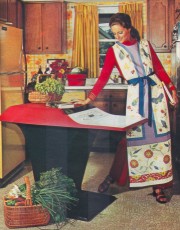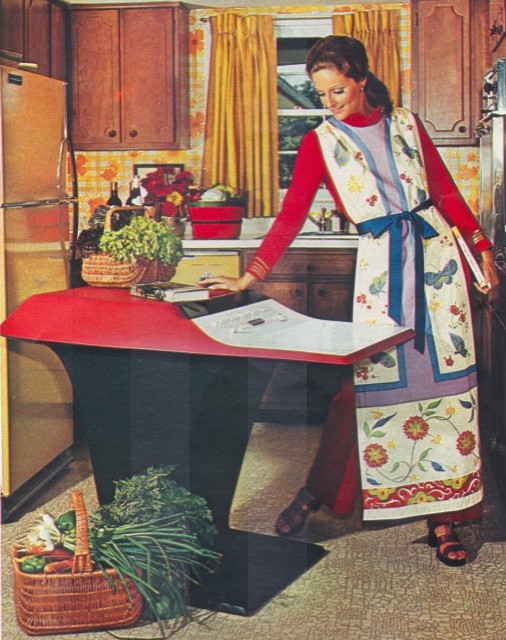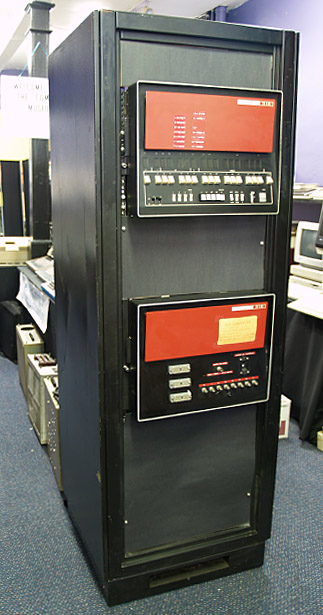 |
We are brick & mortar now!!
Visit us in Parkesburg, PA For more info: www.TheComputerChurch.org (This site no longer maintained.) |

The "Kitchen Computer" is a unique oddity in the history of computing. The famed Neiman-Marcus Christmas catalog made it a practice to offer eye-catching (and wallet-busting) presents that were extravagant and unusual.
In 1969 catalog, Neiman-Marcus decided to feature a computer! It would be a computer that the lady of the house could use to store recipes and, so, it became commonly known as the "Kitchen Computer".
And not just any computer (well, there were not a lot of options in 1969 and this wasn't just any catalog), they chose the Honeywell 316. This computer and it's bigger brother, the Honeywell 516, were the computers used in the very first tests of the Internet. (Coincidentally, the Internet was created in the same year, 1969...but it was a top secret government project at that time. The Honeywell 315 and 516 were used as the "Interface Message Processors" or IMPS.) It probably helped that Neiman-Marcus already used Honeywell computers to manage their stores.
The Honeywell 316, like the computers of its time, was a big, boxy, ugly monstrosity that would not look good in an affluent home. (See picture of how the normal 316 looked) So Neiman-Marcus decided to re-design the computer. Instead of the ugly box, the woman of the house would be getting a sleek red and white computer on a black pedestal. It even included a built in cutting board (the white shelf in the front). This has to be ranked among the most impractical accessories in computer history..."Careful dear, don't get any of those little bones in the computer when you're preparing the fish."
Did anyone buy one?
Some articles claim that the whole Kitchen Computer offer was too impractical to be a serious offer. They suggest it was a publicity stunt and that Neiman-Marcus never intended to sell any computers. However, the Neiman-Marcus Christmas catalog was famous for its impractical and outlandish gifts...and the rich bought them. In the 1968 catalog, Neiman-Marcus offered a pair of Jaguars: a Jaguar XKE Grand Touring Coupe for Him and a Jaguar Coat for Her ($5,559 & $5,975 respectively). Three pairs were sold. In their 1962 catalog, they offered a genuine Chinese junk for $11,500. It had been made in Hong Kong, was 30 feet long with teak decks, mahogany planking and sails. Three people bought the Chinese junk. One can never underestimate how the very rich choose to spend their money. As Edward Marcus said, "no hostess can claim to have the 'mostest' unless she has this marvelous mini-computer to help her plan menus for her family and for dinner guests".
In fact, the Kitchen Computer wasn't the most outlandish offering in the 1969 catalog. That honor would have to go to the tank truck filled with a 100,000 gallons of Aramis men's cologne. The cost for that gift was $5,000,000 and you had to wait until February for delivery!
Given their clientele, the store may have actually expected to sell some of these computers. Edward Marcus said that the computer was "an ideal selection for the catalog because it offers something unique to the modern housemaker who doesn't quite have everything". He went on to say that "he would not be surprised if quite a few Neiman-Marcus customers bought the Honeywell mini-computer".1 He pointed out that not only could the lady of the house use it in her kitchen but that the man of the house could use it to keep track of his stock portfolio and the children could use it to do homework. (Really, the children could use it? I guess he forgot about the two week programming course.)
As far as we know, not one Kitchen Computer was ever sold. The only existing model is currently on display in the Computer History Museum in Mountain View, CA.
Impractical but Prescient
Honeywell had only gotten into the computer business 14 years earlier when they partnered with Raytheon to form Datamatic Corporation. Their first computer, the D-1000, weighed 25 tons and cost $1.5 million2. This project indicates that they were looking ahead to a time when individuals would be able to own computers; a time when computers would move from the corporations to homes. It may seem all too obvious now, but in 1969 there were few people who would see that coming. The vice-president and general manager of Honeywell's Computer Control Division, Paul Bothwell, stated that a computerized home was "very realistic". (see press release for more information)
1 From the official press release for the 1969 Neiman-Marcus Christmas catalog.
2 See Honeywell's website for more information.
Related Item 2: Kitchen Computer Press Release #2
Related Item 3: The Neiman-Marcus Christmas Book 1969
|
Copyright © 2024 by Early Computers Project, All Rights Reserved. |
(Analogs in blue)
- AIM-65 (single board)
- AIM-65 (factory case)
- AIM-65 (Jon Titus)
- ALICE micro-ordinateur
- Altair 680
- Altair 8800
- Altair 8800A
- Altair 8800b
- Altair 8800b Turnkey (see Pertec below)
- Altair 8800b (see Pertec below)
- Altair 8800b w/ Hardisk Controller & Datakeeper
- Altos ACS-8000
- American Basic Science Club Analog Computer
- AMF Educational Computer
- Apple II Plus
- ASCI SystemX
- ASR 33 Teletype
- Automatic Teaching Computer Kit
- Beckman ElectroComp Electric Heating Computer
- Beckman ElectroComp Energy Savings Computer
- Beckman Solid State Fuel Cost Computer
- Brainiac K-30
- Calif. Computer Systems 2200
- CES Ed-Lab 650
- Commodore 8032
- Commodore 64
- Commodore PET 2001
- Commodore Super Pet
- Compucolor II
- Compukit 1
- Compukit 1 Deluxe Model
- Compukit 2
- Compukit UK101
- Comspace CT-650
- Cosmac Elf (RCA1802)
- Cosmac Microtutor
- Cosmac Netronics ELF II
- Cosmac VIP
- Cromemco System I
- Cromemco System III
- Cromemco Z-2D
- Datapoint 2200
- Digi-Comp I (flat box)
- Digi-Comp I (square box)
- Digital Computer Lab
- Donner 3500
- Durango F-85
- Dynabyte
- E & L Inst MMD-1
- E & L Inst MMD-2
- Eagle II
- Electric Tabulating Machine (one original counter, 1889)
- Electronic Associates TR-10
- Electronic Associates TR-10 Model II
- Electronic Associates TR-20
- Electronic Associates TR-48
- Electronic Associates Model 180
- Electronic Associates Model 380 Hybrid
- Geniac
- Google Glass (definitely not vintage)
- Heath EC-1 (factory assembled by Heath)
- Heathkit EC-1 (kit)
- Heathkit ET 3100 trainer
- Heathkit H8
- Heathkit H9 Video Terminal
- Hickok Logic Teaching Sys.
- Hickok Servo Teaching Sys.
- HP 2115A
- HP 85
- HP 5036A
- HP 9825A
- HP 9825B
- HP 9830A
- Iasis 7301
- I-COR MAC-1
- ICS Microcomputer Training System
- IMSAI 108 (prototype)
- IMSAI 8048 Control Computer
- IMSAI 8048 (The Dollhouse Computer)
- IMSAI 8080
- IMSAI PCS-40
- IMSAI PCS-80
- IMSAI VDP-80
- Informer
- Intel Intellec MDS
- Intel MDS-800
- Intel Prompt 48
- Intel SBC 80/10
- Intel SDK-85
- Intel SDK-85 (unassembled)
- Intel SDK-86
- Intertec Superbrain
- ITT MP-EX
- JR-01 Computer
- KIM-1
- LAN-DEC
- LAN-DEC 20
- LAN-ALOG
- Lehrcomputer (Germany)
- Lawrence Livermore Lab
- Lear Siegler ADM3A
- Logikit LK255 (Feedback)
- Logix SF-5000 Electronic Computer
- MAC-1 Mini Analog Computer
- MAC Tutor (Bell Laboratories)
- MEK6800D2
- Micro 68
- Microtan 65
- Midwest Scientific Instruments 6800
- Minivac 601
- Minivac 6010
- Mini-Scamp Microcomputer
- Nascom I
- Nascom II
- National Radio Institute 832
- NEC TK-80
- NorthStar Horizon
- Olivetti Programma 101
- Olivetti Programma 203
- Olivetti Programma 602
- Open University PT501
- Ordinateur d'Apprentissage JR-01
- Osborne 1
- OSI 300
- OSI 600 (SuperBoard II)
- OSI C2-OEM-4
- OSI Challenger-1P
- Pastoriza Personal Analogue Computer
- Pertec MITS 300/25 (Altair desk business system)
- Pertec MITS 300/55 (Altair Turnkey business system)
- PolyMorphic Systems 8810
- PolyMorphic Poly-88
- Protech-83
- Range Keeper Mk.6 Mechanical Analog Computer, 1926
- Range Keeper Mk.7 Mechanical Analog Computer, 1935?
- Sargent-Welch Scientific Company Cat. No.7528 Analog Computer
- Science of Cambridge MK-14 (Sinclair)
- SD Systems Z80 starter kit
- Sharp MZ-40K
- Sharp MZ-80k
- Siemens ECB-85
- Signetics Instructor 50
- Sinclair ZX-81
- Smoke Signal Broadcasting
- Sol-20
- Spark16
- Sphere 1
- Sphere/SWTPC Computer System
- SWTP CMOS Microlab
- SWTP CT-82 Terminal
- SWTPC 6800
- SWTPC 6800 (w/ Smoke Signal Broadcasting drive)
- SWTPC CT-64 Video Terminal, SS-50
- SWTPC TV Typewriter II CT-1024
- Synertek VIM-1
- Synertek SYM-1
- Systron-Donner 3500
- Tei MCS-112
- Tektronix 4006-1
- Telefunken RAT 700
- TI LCM-1001 (Microprogrammer)
- TI LCM-1001 (Microprogrammer)
- TI Silent 700 Terminal
- TI TM 990/189
- Vector 1
- Vector 3
- Vidac 336
- Wang 2200
- Welch Scientific Company Cat. No.7528 Analog Computer
- Xerox 820 Mark I
- Chameleon Plus
- Commodore SX64
- Epson HX-20
- Kaypro I
- Kaypro II
- Kaypro 2x
- Kaypro 16
- Osborne 1
- Panasonic Senior Partner
- Visual Commuter
- Babbage's Calculating Engine (1834)
- Electric Tabulating Machine (1889, Herman Hollerith's personal copy)
- The Hollerith Electric Tabulating System (1890)
- Counting a Nation by Electricity (1891)
- Calculating Machines (1947)
- Moore School Lectures Vol. II (1947)
- Mathematical Theory of Communication (1948)
- Communication Theory of Secrecy Systems (1949)
- The "Moore's Law" article (Electronics, 1965)
- Printout from Babbage's Difference Engine #2 (London Science Museum, 2004)

